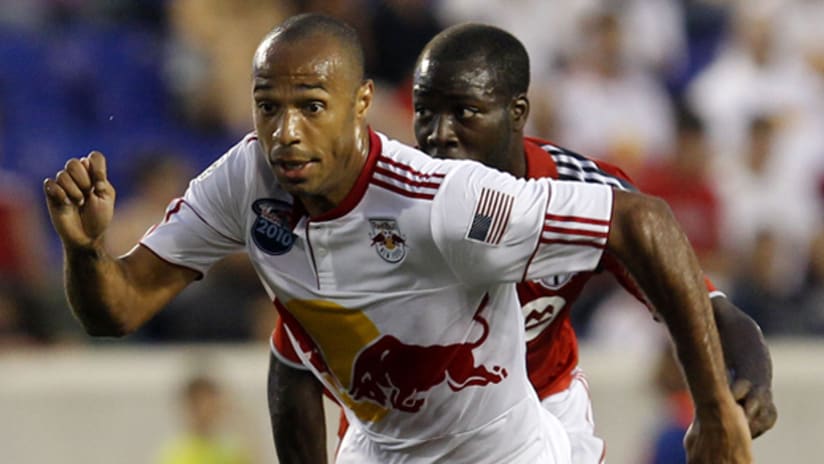Thierry Henry is a fabulous player, as technically gifted as the June day is long. Those long legs provide ample pace. He’s obviously competitive; practice reports say the Red Bulls attacker has that “win-everything” mentality, determined to be victorious on every single training-ground activity.
So in one sense, it doesn’t matter where Henry lines up on the field. If Red Bulls manager Hans Backe asked the rangy French international to perform at left back, Henry could probably put that big soccer brain to work and figure it out lickety-split.
Still, that doesn’t mean that Backe, his assistants and Henry himself shouldn’t put heads together and determine the man’s optimum role at Red Bull Arena, where Henry finally broke the goal-scoring seal last Saturday. There are some subtle choices, after all, as the Frenchman has successfully deployed in slightly different roles throughout his storied career.
Henry has always been somewhat unconventional in that his starting position is close to goal—but he’s most comfortable operating further from goal than traditional 6-yard box poachers. He’s no Ruud van Nistelrooy, for sure.
So he often starts as the lead man, but rarely finishes there.
READ: Henry says first MLS goal was "coming for a couple of games"
At Barcelona, Henry frequently operated as such. His starting positions at the Nou Camp were perhaps more withdrawn than similar types. So he ended up playing very close to versatile attacker Leo Messi or midfielder Andrés Iniesta. The shape, ostensibly a 4-2-3-1, ended up looking like something closer to a 4-2-4. Anyone remember the old 4-2-4 used so successfully by some fabulous and flummoxing Brazilian sides of the 1960s and 1970s?
In this formation, Henry drifted so far into the midfield—maintaining the fluid movement and beautiful spacing that make Barcelona so special under coach Pep Guardiola—that he was frequently behind his wide players upon receipt of possession.
He doesn’t tend to drift as far back in New York. Rather, he plays a little further ahead, usually a little left of Juan Pablo Angel. Mostly, Henry can be found somewhere just beyond the penalty area as the ball moves into New York’s offensive half.
[inline_node:317138]From there ... well, it’s all still in the works. Henry has appeared in just six league games so far. But so far his relationship with Joel Lindpere on the left is developing differently than his relationship with Dane Richards to the right.
Henry moves toward the ball and then sets up quickly, looking to spring Richards on the right. Or he looks to combine with Lindpere in a way that moves the Estonian down the left side in stages (as opposed to the flashing, dashing runs of Richards on the right). Or he’ll “throw a change-up,” combining with Ángel within the middle channel.
No one has benefited more than Richards from Henry’s arrival. (Also from the arrival of Rafa Márquez, of course.) Richards may have had his best game yet as a Red Bull with a terrific goal and equally worthwhile assist in the home team’s commanding 2-0 win last Saturday over San Jose.
WATCH: Henry opens MLS scoring account for New York
Going forward, Henry could possibly begin moving his starting positions just a little closer to goal. With Ángel around, the pair would need to be careful not to become redundant inside the penalty area. On the other hand, the closer Henry gets to goal, the more he becomes an immediate threat, the initial focus of nearby defenders. That would create more room still for Richards to run at defenders from the right.
It would also give Ángel more room to check back toward the midfield. That’s sometimes the way it worked for Barcelona. When Henry played nearer to goal, Messi or Pedro had more operating room on the right and in the center-right areas of the field.
Or, Henry could even line up a little further left, more as he did back in the day at Arsenal. On those teams (circa 2002-04), Henry drifted left, waiting for Dennis Bergkamp to gather the ball and make smart, early passes to the wing. (On the right side of those teams, by the way, was none other than fast Freddie Ljungberg.)
Henry has obviously lost some pace. But to watch him glide by defenders as he has occasionally in MLS matches, you know he’s still got it in him—at least a few times a game if not as consistently as before.
But given that fading pace, he does seem best-suited for the more central withdrawn role. He won’t play it the way Landon Donovan does; when the LA Galaxy’s main man lines up there, he drifts wider and deeper in order to get the ball and then run at defenders. Rather, Henry will look more like Bergkamp, gathering and distributing, while remaining capable of the occasional menacing turn.
What’s great about watching Henry is his timing. On the one hand, the way he’s playing at the moment, defenders usually know where to find him: near the top of the penalty area. That’s where he starts and, as the play develops, that’s mostly where he hangs out.
Until, that is, the moment of truth arrives. His timing of separation from defenders and on runs to the near or far post is something to behold.
That’s how he scored his first MLS goal over the weekend. And that’s how he’s likely to score plenty more before this season is done.


